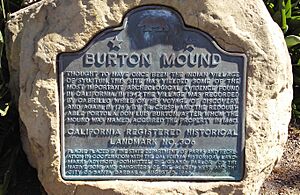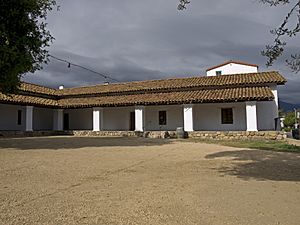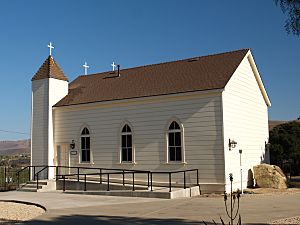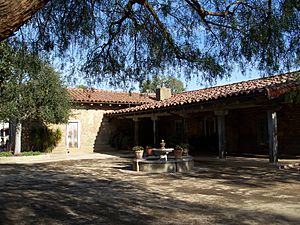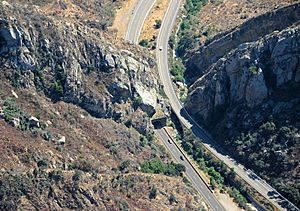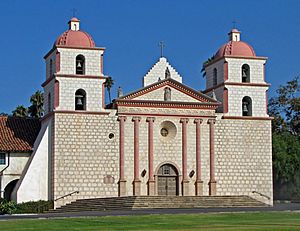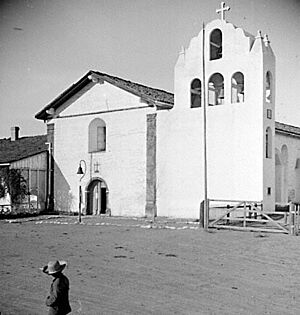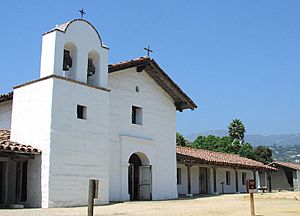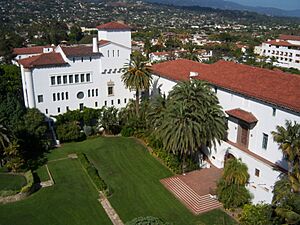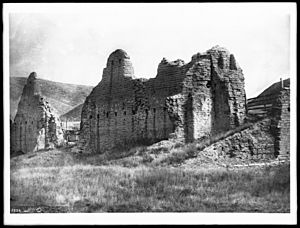California Historical Landmarks in Santa Barbara County facts for kids
California is full of amazing historical places, and Santa Barbara County is no exception! This beautiful area is home to many important sites known as California Historical Landmarks. These landmarks are special spots that tell us about California's past, from ancient Native American villages to old missions and important buildings. They help us understand the people, events, and changes that shaped this part of the state.
Contents
- Exploring Santa Barbara's History
- Important Landmarks to Discover
- Burton Mound
- Carpinteria and Indian Village of Mishopshnow
- Carrillo Adobe
- Casa de la Guerra
- Chapel of San Ramon
- Covarrubias Adobe
- Gaviota Pass
- Hastings Adobe
- Mission La Purisima Concepción
- Lobero Theatre
- Mission Santa Barbara
- Mission Santa Inés
- Presidio of Santa Barbara
- Santa Barbara County Courthouse
- Site of original mission and remaining ruins of La Purisima Mission
- Well, Hill 4
- Important Landmarks to Discover
Exploring Santa Barbara's History
Santa Barbara County has a rich history, stretching back thousands of years. Before Europeans arrived, the Chumash people lived here, building thriving communities. Later, Spanish explorers and missionaries came, establishing missions and presidios (forts). As California grew, new towns and industries developed. The landmarks in this county help us trace these different periods, offering a glimpse into the lives of those who came before us.
Important Landmarks to Discover
Let's explore some of the fascinating California Historical Landmarks you can find in Santa Barbara County. Each one has a unique story to tell!
Burton Mound
Burton Mound is a very old site in Santa Barbara, located near the beach. It was once a large village of the Chumash people, who lived in this area for thousands of years. This mound is important because it shows us where a significant Native American community once thrived. It helps us remember the original inhabitants of this land.
Carpinteria and Indian Village of Mishopshnow
The area around Carpinteria was also home to a large Chumash village called Mishopshnow. This landmark reminds us of the rich culture and history of the Native Americans who lived along the coast. The village was known for its skilled craftspeople and its location near tar pits, which provided material for waterproofing canoes.
Carrillo Adobe
The Carrillo Adobe is one of the oldest buildings in Santa Barbara. An adobe is a type of building made from sun-dried mud bricks. This historic home was built in 1825 by Daniel Hill for his wife, Josefa Carrillo. It's a great example of early California architecture and gives us an idea of how people lived almost 200 years ago. It is also listed on the National Register of Historic Places, which means it's recognized as a very important historical site across the country.
Casa de la Guerra
The Casa de la Guerra is another significant adobe building in Santa Barbara. It was built in 1818 for José de la Guerra, who was the commander of the Presidio of Santa Barbara. This large house was a center of social and political life in early Santa Barbara. It's a wonderful place to visit to imagine what life was like during the Spanish and Mexican periods in California. This site is also on the National Register of Historic Places.
Chapel of San Ramon
The Chapel of San Ramon is a historic chapel located near Santa Maria. It was built in 1875 and served as a spiritual center for the people living in the remote Tepusquet Canyon. This small chapel represents the early religious life and community spirit of the settlers in this rural area of Santa Barbara County.
Covarrubias Adobe
The Covarrubias Adobe is another important historic adobe building in Santa Barbara. Built around 1817, it was part of the original Presidio of Santa Barbara complex. It's known for its beautiful architecture and its connection to early Californian families. It helps us understand the layout and style of homes during the Spanish colonial era.
Gaviota Pass
Gaviota Pass is a narrow mountain pass that has been a crucial travel route for centuries. Located along U.S. Route 101 near Goleta, this pass was historically a challenging obstacle for travelers. It played a role in various historical events, including battles during the Mexican-American War. Today, it's a scenic and important part of the county's transportation history.
Hastings Adobe
The Hastings Adobe, also known as the Trussell-Winchester Adobe, is another historic adobe home in Santa Barbara. Built in 1854, it shows the continued use of adobe construction even after California became part of the United States. It offers a glimpse into the lives of early American settlers in the area.
Mission La Purisima Concepción
Mission La Purisima Concepción is one of the 21 California missions, located near Lompoc. Founded in 1787, it was severely damaged by an earthquake in 1812 and then rebuilt in a new location. Today, it's one of the most fully restored missions in California, giving visitors a clear picture of mission life. It's also a National Register of Historic Places site.
Lobero Theatre
The Lobero Theatre in Santa Barbara is the oldest continuously operating theater in California. It was first built in 1873 by José Lobero and later rebuilt in 1924. This landmark is important for its role in the arts and culture of Santa Barbara, hosting countless performances over the years. It's a living piece of history for performing arts lovers.
Mission Santa Barbara
Mission Santa Barbara is often called the "Queen of the Missions" because of its beautiful architecture and well-preserved grounds. Founded in 1786, it's one of the most iconic landmarks in Santa Barbara. It has served as a religious and cultural center for over 200 years. This mission is also listed on the National Register of Historic Places.
Mission Santa Inés
Mission Santa Inés is another of California's historic missions, located in Solvang. Founded in 1804, it was the 19th of the 21 California missions. It played an important role in the development of the Santa Ynez Valley. The mission's beautiful church and grounds offer a peaceful look into the past.
Presidio of Santa Barbara
The Presidio of Santa Barbara was a Spanish military outpost, or fort, established in 1782. It was one of four presidios built in California to protect the missions and Spanish settlements. Today, parts of the original presidio have been reconstructed, allowing visitors to explore what life was like for soldiers and their families in early California. It is also a National Register of Historic Places site.
Santa Barbara County Courthouse
The Santa Barbara County Courthouse is not just a place where legal matters are handled; it's also a stunning architectural masterpiece. Built in 1929, its Spanish-Moorish style is famous. It's a working courthouse, but also a popular tourist attraction because of its beautiful murals, gardens, and clock tower with amazing views. It is also listed on the National Register of Historic Places.
Site of original mission and remaining ruins of La Purisima Mission
While the main Mission La Purisima Concepción was rebuilt, the Site of original mission and remaining ruins of La Purisima Mission marks the location of the very first mission building. After the devastating earthquake of 1812, the mission was moved. These ruins in Lompoc remind us of the challenges faced by early settlers and the resilience required to rebuild.
Well, Hill 4
Well, Hill 4 is a significant landmark in the history of California's oil industry. Located near Lompoc in the Mission Hills District, this site marks one of the earliest successful oil wells in the state. It represents the beginning of a major industry that shaped California's economy and development.


